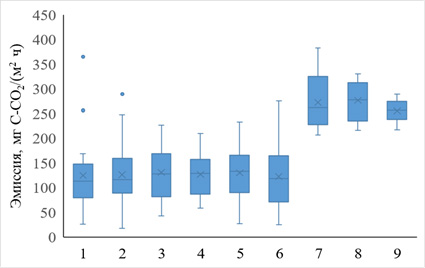Carbon polygon (test site) "Pokrovsky": methodological aspects of setting up a field experiment to assess the impact of perennial forage grasses on carbon sequestration by soils of agroecosystems
DOI:
https://doi.org/10.31251/pos.v8i3.318Keywords:
sod-podzolic soils; carbon polygon; field plot experiment; ground cover crops; carbon sequestration; CO2 emission.Abstract
The aim of the study was to assess the main characteristics of the land use history and soil properties of fallow areas allocated for experimental plots at the “Pokrovsky” carbon test site and justify of the methodology for arranging a field experiment.
Location and time of the study. The study was conducted in the experimental fields of the “Pokrovsky” test site, located in the center of the East European Plain, on the border of the Smolensk and Kaluga regions in the middle reaches of the Ugra River in 2023–2024.
Methods. The study involved description of the of land use history based on historical cartographic materials, detailed mapping of the soil cover of the site, assessing the chemical, physical, agrochemical properties of soils using common methods, as well as assessing their biological activity by measuring CO2 emissions from the soil surface using the chamber method.
Results. Agricultural sod-podzolic soils of the experimental fields were characterized by low humus storage and an average nutrient supply with high degree variation. Carbon storage in the 20 cm layer was 38,3 and 41,3 t/ha for the two experimental fields, used in the study. It was found that in spring, before sowing crops, the soil replicates in both experimental field did not differ significantly in such indicators as temperature, moisture, CO2 emission. The contribution of root respiration to CO2 emission was about 50% at the peak of vegetation for cereal mixtures and legumes.
Conclusions. By the summer of 2024 the “Pokrovsky” carbon test site had four experimental plots located on two fields. Three plots were set up at the beginning of 2023: monodominant planting of red clover, a mixture of perennial cereal crops and red clover, and perennial cereal crops. At the fourth site, at the end of spring 2024, a single-factor field plot experiment was established with perennial legume-cereal mixtures selected taking into account their physiological characteristics and impact on carbon sequestration, on plots identical in chemical and biological properties.
Downloads

Downloads
Published
How to Cite
Issue
Section
License
Copyright (c) 2025 The Journal of Soils and Environment

This work is licensed under a Creative Commons Attribution 4.0 International License.






